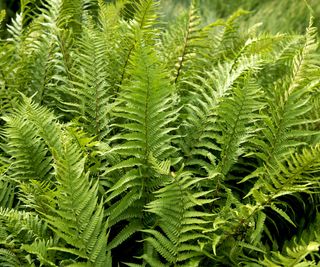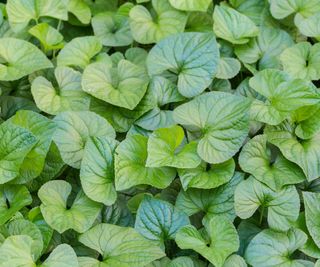Native shade-loving plants are perfect for those difficult areas of the garden where other plants struggle to thrive. Many plants that thrive in shade are native to many parts of the United States, but you can always check with your local extension office for local species. You won’t regret planting some of these native shade-loving plants, which are adapted to your environment; they benefit wildlife and attract native pollinators to your garden.
Native shade trees
There are many native shade trees to choose from. Here are eight of our favorites.
1. Fern

(Image source: Feifei Cui-Paoluzzo / Getty Images)
Most ferns thrive in shade, and many are native to North America. Some examples include the fairy fern, lady fern, cinnamon fern, and ostrich fern. Native ferns can be found in a wide range of sizes, from ten inches (25 cm) to four feet (1.2 m) tall. They are one of the native plants that do best in shade. The shadiest areas of the garden, where not much else grows, are ideal for ferns. Many ferns prefer moist soil, so avoid planting them in dry areas.

This Dennstaedtia punctilobula fern from Green Promise Farms can grow anywhere. Sun, shade – it doesn’t care!
2. Virginia Bluebell (Mertensia virginica)

(Image source: Joshua Moore / Getty Images)
This beautiful wildflower is a shade-loving perennial that grows best in moist areas of the garden. Virginia bluebells are native to the eastern United States and Canada and as far west as Kansas. The blue bell-shaped flowers bloom in early spring to signal the start of the new season. Plant bluebells in zones 3 through 9.
3. Hepatica (Hepatica acutiloba and H. americana)

(Image source: Brian Woolman / Getty Images)
Another attractive woodland flower, hepatica is perfect for shade gardens. There are two species native to North America: round-lobed hepatica and pointed-lobed hepatica. The different names describe the shape of the leaves. Both bloom in spring with blue, pink, lavender, or white flowers. They grow low and in clumps and are hardy in zones 3 to 8.
4. Wild ginger (Asarum spp.)

(Image source: anmbph / Getty Images)
You will find several species of wild ginger native to most of eastern and central North America. Grow wild ginger for its attractive foliage, which grows low and is suitable for planting in clumps or as a groundcover in shade. Most species are hardy in zones 3 through 9. Wild ginger prefers rich soil and tolerates moisture.
5. Cornus spp.

(Image source: Simon McGill / Getty Images)
Several species of dogwood are native to different regions of the United States. Examples include the Oriental dogwood and the Pacific dogwood. All are shade tolerant and perfect for a woodland corner of the garden. Most are small shrubs, but the creeping dogwood is a low-growing, spreading tree. Dogwoods prefer moist, well-drained soil and offer spring flowers and fall foliage color.

This compact dogwood blooms white flowers in the spring, but really comes into its own in the fall, when the foliage turns a stunning fiery red!
6. Rhododendron spp.

(Image source: Jacky Parker Photography / Getty Images)
Like dogwoods, native rhododendrons thrive in shady, wooded areas. You can find several native species in a variety of flower colors and heights. Florida rhododendrons are native to the Southeast with bright colors and high heat tolerance. Piedmont rhododendrons are native from North Carolina west to Texas and are one of the taller species.

Rose Gardening Tool Set – Small Design (5′ x 7′)
Want to expand beyond azaleas? This set from Plant by Number includes an azalea bush plus six pink plants.
7. Eastern Gama Grass (Tripsacum dactyloides)

(Image source: Sandi Smolker / Getty Images)
Most native ornamental grasses prefer full sun, but you can grow oriental gamagrass in partial shade. It can grow up to 12 feet (3.7 m) tall, but it often stays much shorter than that in the garden. It is an accent in shady areas with room to grow, and is a home to native butterflies.
8. Virginia Bluebell (Itea virginica)

(Image source: igaguri_1 / Getty Images)
Virginia sweetspire is a large deciduous to semi-evergreen shrub with long, arching clusters of white flowers in spring. It also provides fall color with its red and purple foliage. It grows best in rich, moist soil in partial shade. Native to the Southeast, Virginia sweetspire is hardy in zones 5 through 9.
There are many native shade-loving plants to choose from, and these are just a few examples. Look for woodland species for best results. These are plants that are naturally adapted to partial shade, dappled shade, or even deep shade.
This article introduces products available from third-party vendors on Gardening Guide Store.
